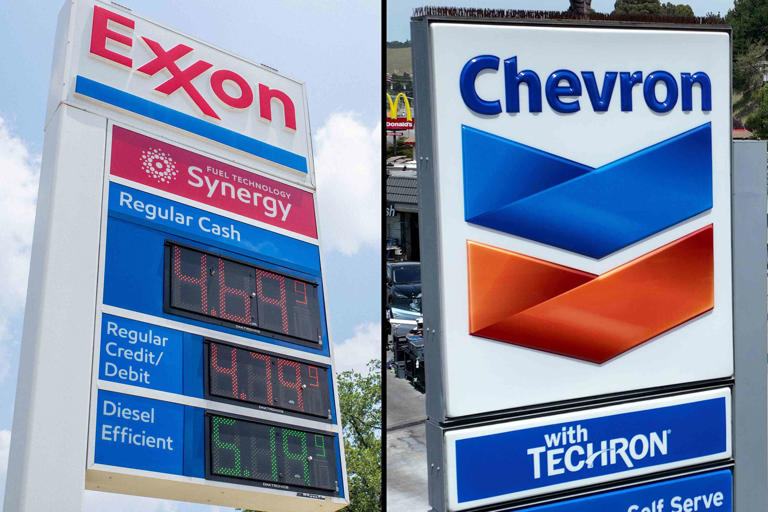In the ever-evolving landscape of the oil and gas industry, ExxonMobil and Chevron, two of the largest U.S. energy corporations, have showcased contrasting performances in their second-quarter financial results. The divergent paths of these two oil giants underscore the complexities and challenges within the sector, reflecting their respective strategies and market conditions.
ExxonMobil’s Record Production and Strong Earnings Performance
ExxonMobil (XOM) emerged as a standout performer this quarter, buoyed by record production levels and strategic acquisitions. The company reported a significant year-over-year increase in net earnings, which rose by 17% to reach $9.2 billion, or $2.14 per share. This impressive earnings result exceeded analysts’ expectations by 10 cents per share, marking ExxonMobil’s first quarterly profit gain in over a year. The turnaround is particularly notable given the previous four consecutive quarters of declining earnings, which had been a reflection of the broader downturn following the extraordinary profit surge seen in 2022 due to soaring oil prices amid geopolitical turmoil.
One of the key drivers behind ExxonMobil’s strong performance was its record production levels, especially from its operations in the Permian Basin and Guyana. The company achieved a notable 15% increase in total net production from the first quarter, reaching 574,000 oil-equivalent barrels per day. This level of production is the highest ExxonMobil has recorded since its merger with Mobil in 1999. The boost in production not only enhanced the firm’s overall profitability but also contributed to a significant rise in its upstream U.S. production business profits, which more than doubled to $2.4 billion from $1.1 billion in the previous quarter.
A major factor in ExxonMobil’s recent success was its $60 billion acquisition of Pioneer Natural Resources, finalized during the quarter. This strategic acquisition substantially increased ExxonMobil’s Permian production capacity and directly contributed $500 million to its earnings for the quarter. The move has been seen as a strategic play to solidify ExxonMobil’s position in one of the most productive oil regions in the world.
Despite a broader market selloff on Friday, ExxonMobil’s shares managed to climb by as much as 1.5% in early trading. This positive movement in ExxonMobil’s stock, even amidst a challenging market environment, highlights the company’s resilience and its ability to deliver strong financial performance despite external pressures.
Chevron’s Struggles and Strategic Shifts
In stark contrast, Chevron (CVX) faced a more challenging quarter, with its earnings falling short of consensus expectations. The company reported a 19% decline in adjusted profit, totaling $4.7 billion, or $2.55 per share. This result was 43 cents below analyst forecasts and reflects a broader struggle with weak non-U.S. upstream production and significantly reduced refining income compared to the same period last year.
Chevron’s difficulties were exacerbated by ongoing issues related to its attempted $53 billion acquisition of Hess. The acquisition, which is intended to expand Chevron’s footprint in key energy markets, has encountered delays due to an arbitration case filed by ExxonMobil. ExxonMobil’s claim involves a right of first refusal on Hess’s 30% stake in a major Guyana project, and the resolution of this case is not expected until May 2025. The uncertainty surrounding this deal has added to Chevron’s operational and financial challenges.
In addition to these issues, Chevron has announced several strategic changes, including relocating its headquarters from California to Houston, Texas. This move is part of Chevron’s broader strategy to align itself more closely with the heart of the U.S. energy industry. The relocation is also seen as a response to California’s stringent climate regulations, which Chevron executives have criticized for contributing to high gasoline prices relative to other parts of the country. The shift to Texas reflects a trend seen among several major firms that have relocated to the state in recent years, including Oracle, Tesla, Charles Schwab, and Hewlett Packard.
Market Implications and Future Outlook
The contrasting performances of ExxonMobil and Chevron underscore the varied challenges and opportunities within the oil and gas sector. ExxonMobil’s strong earnings and record production highlight its effective strategy and successful integration of recent acquisitions, positioning the company as a leader in the industry. In contrast, Chevron’s struggles with profitability and strategic delays reflect the difficulties faced by companies in navigating complex market conditions and regulatory environments.
As ExxonMobil continues to benefit from its robust production capabilities and strategic investments, Chevron’s focus on restructuring and strategic relocations will be crucial in its efforts to regain financial stability and operational efficiency. The evolving landscape of the oil and gas sector, combined with shifting market dynamics and regulatory pressures, will play a significant role in shaping the future trajectories of these two major energy giants.
